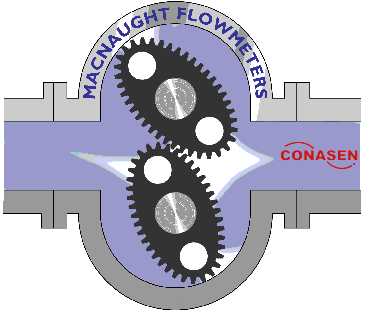Oval gear meters are traditional, mechanical, positive displacement (PD) flow meters, first invented more than 50 years ago by OVAL Corporation of Japan and now widely used for flow metering applications.
Oval gear meters measure flow by employing a geared rotor to pass known volumes of fluid through a housing.
Oval Gear Meter
A very precisely adjusted gear pair within the casing forms the measuring element. The in-flowing medium causes the gear pair to rotate.
The rotary motion is scanned by contactless sensors. Since each individual tooth generates a pulse, this results in a very high resolution.
Consequently, even the smallest volumes can be measured or dosed precisely. The measurement unit contains two pick-offs that are circumferentially offset by ? a tooth pitch to generate a 2-channel flow-proportional frequency signal.
Suitable processing of the signal provides a greater resolution and the option to identify the flow direction. Basically, the measurement accuracy increases with an increase in the viscosity of the media.

The oval gear flow meter comprises oval-shaped, geared rotors that rotate within a housing of specified geometry. Fluid differential pressure causes the intermeshing gears to rotate, trapping a ‘pocket’ of fluid between the gear and the outer housing and subsequently emptying the fluid pocket into the downstream flow.
The capillary action of the metered fluid forms a liquid seal. Each ‘pocket’ holds a precise and known volume of fluid so counting the pocket frequency gives a measurement of the volumetric flow rate. This is typically achieved by embedding magnets in the rotors, which then actuate a reed switch or provide a pulse output as they rotate.

Advantages of OVAL Gear Meter
- Traditional proven flow technology
- Simple to install
- No straight pipe runs are required so flow meters can be installed in restricted areas
Limitations of OVAL Gear Meter
- Not suitable for steam or multi-phase fluids
- Fluid slippage adversely affects accuracy; this varies with flow rate, differential pressure, temperature, viscosity, and clearance
- Not recommended for low-viscosity fluids, including water or water-like fluids (because of an increase in fluid slippage)
- Accuracy is adversely affected by bubbles present in fluids
Applications of OVAL Gear Meter
The oval gear flow meter is designed primarily for use with higher-viscosity fluids, which has led to applications such as the flow metering of oils, syrups, and fuels.
If you liked this article, then please subscribe to our YouTube Channel for Instrumentation, Electrical, PLC, and SCADA video tutorials.
You can also follow us on Facebook and Twitter to receive daily updates.
Read Next:
- Flowmeter Control Strategy
- What is Averaging Pitot Tube?
- Basics of Venturi Flow Meter
- Differential Pressure Flowmeter
- Flow Transmitter Square-Root
In oval gear type flow meter,relation between frequency and flow
Is the flow affected by the down stream pressure?